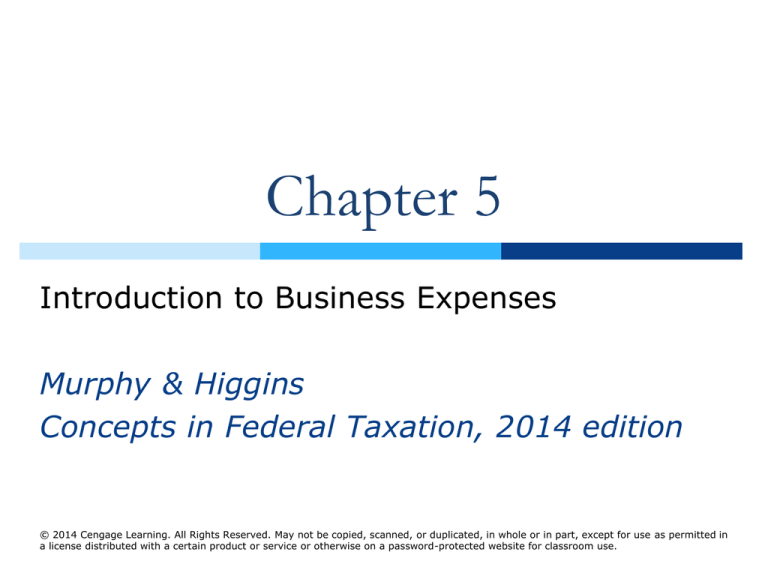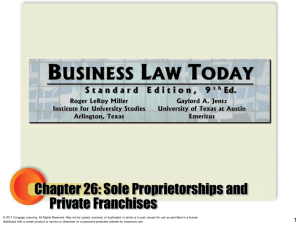
Chapter 5
Introduction to Business Expenses
Murphy & Higgins
Concepts in Federal Taxation, 2014 edition
© 2014 Cengage Learning. All Rights Reserved. May not be copied, scanned, or duplicated, in whole or in part, except for use as permitted in
a license distributed with a certain product or service or otherwise on a password-protected website for classroom use.
Concept Review
All tax deductions are a matter of
Legislative Grace
Deductions are part of Congress’ approach
to implementation of Ability-to-Pay
© 2014 Cengage Learning. All Rights Reserved. May not be copied, scanned, or duplicated, in whole or in part, except for
use as permitted in a license distributed with a certain product or service or otherwise on a password-protected website for
classroom use.
Review
All deductible amounts fall into one of
three categories:
Business Expenses (Chapters 5 & 6)
Losses (Chapter 7)
Other Itemized Deductions (Chapter 8)
Two primary types of deductions allowed:
Deductions for adjusted gross income
Generally have a business purpose
Deductions from adjusted gross income
Generally have a personal purpose
© 2014 Cengage Learning. All Rights Reserved. May not be copied, scanned, or duplicated, in whole or in part, except for
use as permitted in a license distributed with a certain product or service or otherwise on a password-protected website for
classroom use.
Conduit Entity Reporting
Conduit entities are not subject to tax, but
results of operations flow-through to
owners’ returns
Items subject to special tax treatment are
kept separate
Items not subject to special tax treatment
are netted to arrive at ordinary net income
or net loss
© 2014Cengage Learning. All Rights Reserved. May not be copied, scanned, or duplicated, in whole or in part, except for
use as permitted in a license distributed with a certain product or service or otherwise on a password-protected website for
classroom use.
Classification of Deductions
All expenditures fall into two categories:
Profit-motivated
Trade or business expenses
Expenses for the production of income (Investment)
Personal
Specifically allowed itemized deductions
Nondeductible personal expenses
© 2014 Cengage Learning. All Rights Reserved. May not be copied, scanned, or duplicated, in whole or in part, except for
use as permitted in a license distributed with a certain product or service or otherwise on a password-protected website for
classroom use.
Profit-Motivated Expenditures
To be deductible, an
expenditure must have a
bona fide business purpose
unrelated to its tax effect
Must show that the expense is
related to a profit-motivated
transaction
Must show that the business
purpose is the primary or
dominant motive
Rental activities
May be either trade or
business or an investment
activity
Expenses are always
deducted for AGI
Classification matters when
property is sold
Classification is determined by
the scope of the taxpayer’s
involvement
Trade or business
Requirements to qualify:
Primary purpose is to earn
income or a profit
Involvement is regular and
continuous
Activity is not merely a hobby
© 2014 Cengage Learning. All Rights Reserved. May not be copied, scanned, or duplicated, in whole or in part, except for
use as permitted in a license distributed with a certain product or service or otherwise on a password-protected website for
classroom use.
Mixed Use: Business & Personal Use
Mixed-Use Assets
Used both to earn income
and for personal purposes
Mixed-Use
Expenditures
Incurred both for profit and
personal reasons
Allocate between business
and personal use and
deducted as allowed
Treat as two separate
assets by allocating
amount of use
© 2014 Cengage Learning. All Rights Reserved. May not be copied, scanned, or duplicated, in whole or in part, except for
use as permitted in a license distributed with a certain product or service or otherwise on a password-protected website for
classroom use.
Tests for Deductibility
To be deductible, expenses must be profitmotivated or specifically allowed, and also
Ordinary
Necessary
Normal, common, generally accepted
Appropriate, helpful, prudent
Reasonable in amount
Arm’s length
© 2014 Cengage Learning. All Rights Reserved. May not be copied, scanned, or duplicated, in whole or in part, except for
use as permitted in a license distributed with a certain product or service or otherwise on a password-protected website for
classroom use.
Five Negative Tests for Deductibility
To be deductible, expenses
must not be
Against Public Policy
Personal
Business purpose is not primary
motive
Not specifically allowed
Capital Expenditures
Should be capitalized as assets if
useful life extends beyond a year
Start-up costs
Resulting from violation of a law
Resulting from an illegal business
May expense $5,000 in first year;
remainder is amortized over 180
months
First year expense is phased-out
if total costs > $50,000
For lobbying and political activities
Costs to influence local
legislation are deductible
Costs to monitor any legislation
are deductible
Related to Tax-Exempt Income
Cost of goods sold is always
deductible under the capital
recovery concept
Ordinary, necessary, and
reasonable business expenses
are deductible for all illegal
businesses except sale of illegal
drugs
Incurred to generate tax-exempt
income
Another Person’s Obligation
Cannot recover another’s capital
© 2014 Cengage Learning. All Rights Reserved. May not be copied, scanned, or duplicated, in whole or in part, except for
use as permitted in a license distributed with a certain product or service or otherwise on a password-protected website for
classroom use.
Mixed Use: Hobby versus Business
An income-earning activity
without a predominant profit
motive is a hobby
Losses from a hobby are not
deductible
Expenses allowed up to amount of
income generated
Deductions taken using three tier
system:
Factors considered in
determining profit-motive:
Manner of conducting activity
Expertise or reliance on
expert advice
Time and effort spent on
activity
History of income and loss
Amount of occasional profit
Elements of personal pleasure
Financial status
Success in similar activities
Expenses also allowed as either
business or itemized deductions
Other expenses that qualify as
business expenses
Depreciation on assets used
Allowable expenses are deducted
from AGI
© 2014 Cengage Learning. All Rights Reserved. May not be copied, scanned, or duplicated, in whole or in part, except for
use as permitted in a license distributed with a certain product or service or otherwise on a password-protected website for
classroom use.
Mixed Use: Vacation Home
A residence used for personal vacations and
also rented to unrelated people is a mixeduse asset and first must be classified as
either:
Personal residence if rented 14 days or fewer in a
year
Vacation home if used personally
more than 14 days, or
more than 10% of the number of days rented
Rental property if used personally
less than or equal to 14 days, or
less than or equal to 10% of the days rented
© 2014 Cengage Learning. All Rights Reserved. May not be copied, scanned, or duplicated, in whole or in part, except for
use as permitted in a license distributed with a certain product or service or otherwise on a password-protected website for
classroom use.
Vacation Home Tax Treatment
If classification is:
Then tax treatment is:
Personal residence
Report no income or
expense
Vacation home
Report income and
allocate expenses using
three tier system (no
loss allowed)
Rental property
Report income and
allocate all expenses;
Loss allowed
© 2014 Cengage Learning. All Rights Reserved. May not be copied, scanned, or duplicated, in whole or in part, except for
use as permitted in a license distributed with a certain product or service or otherwise on a password-protected website for
classroom use.
Mixed Use: Home Office
A specific portion of the home must be used
Exclusively and regularly,
As the principal place of business or
As a place to meet clients, but
Employees must also show that the use
If taxpayer has no other available location to do administrative or
management activities, this requirement will not disqualify the deduction
Is for the convenience of their employer
Required as a condition of employment
Allowed expenses are deducted using the three tier system
Deduction is limited to the amount of net income from the
business
Home-office deduction may not create a loss
Excess may be carried-forward
© 2014 Cengage Learning. All Rights Reserved. May not be copied, scanned, or duplicated, in whole or in part, except for
use as permitted in a license distributed with a certain product or service or otherwise on a password-protected website for
classroom use.
Timing of Deductions
The taxpayer’s accounting method is used to
determine the timing of deductions
Cash Method: Claim a deduction in the year an
expense is paid
Date of mailing for checks
Date of charge for credit cards
Prepaid expenses are deductible if used within one tax year
(prepaid interest does not qualify)
Accrual Method: Claim a deduction in the year
two tests are met
All-events test is met when a liability exists and the amount can
be determined
Economic performance test is met when services or property are
provided
© 2014 Cengage Learning. All Rights Reserved. May not be copied, scanned, or duplicated, in whole or in part, except for
use as permitted in a license distributed with a certain product or service or otherwise on a password-protected website for
classroom use.
Timing of Deductions
Related Party Accrued Expenses
Deductions for accrued expenses payable
to a cash basis related party are limited
Related parties include family members and
businesses owned or controlled by the taxpayer
Unless both parties are accrual basis, both report
using the cash method; until income is reported no
expense may be deducted
© 2014 Cengage Learning. All Rights Reserved. May not be copied, scanned, or duplicated, in whole or in part, except for
use as permitted in a license distributed with a certain product or service or otherwise on a password-protected website for
classroom use.
Financial Accounting Income
versus Taxable Income
Matching and Conservatism are not tax
concepts
Estimates of expenses are not permitted
for tax purposes
Use specific write-off for bad debts
Do not estimate warranty expense
© 2013 Cengage Learning. All Rights Reserved. May not be copied, scanned, or duplicated, in whole or in part, except for
use as permitted in a license distributed with a certain product or service or otherwise on a password-protected website for
classroom use.







